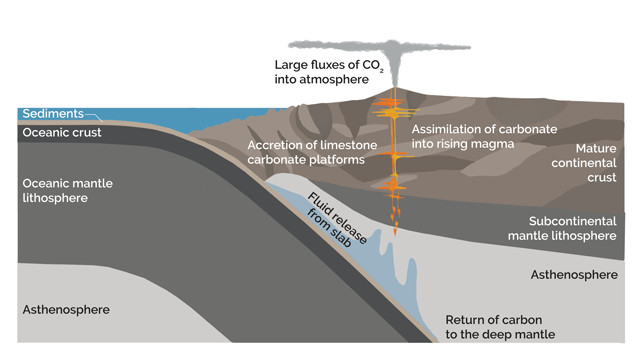
by Mary Caperton Morton Friday, October 13, 2017

New research suggests that arc volcanoes, which release large amounts of carbon when they erupt, draw their carbon from limestone platforms found along subduction zones. Credit: K. Cantner, AGI.
Volcanoes have been the main source of atmospheric carbon over Earth’s history, with some types of eruptions injecting more carbon into the atmosphere than others. Arc volcanoes, for example, which form in chains along subduction zones, are responsible for up to two-thirds of all volcanic carbon emissions today, and have likely been major contributors for as long as they’ve existed. New research suggests a reason why: These volcanoes draw large amounts of carbon from limestone platforms found along many subduction zones. The finding has implications for how the volcanic carbon cycle affects climate over geologic timescales.
Arc volcanoes occur along subduction zones, where partial melting of downgoing plates produces magmas that rise and form volcanoes atop the overriding plates. In a new study in Science, researchers looked at the volumes and carbon isotope ratios of emissions from 80 arc volcanoes around the world to determine the source of the emitted carbon. They drew upon previously published data collected by researchers involved in the Deep Carbon Observatory’s Deep Earth Carbon Degassing (DECADE) initiative, which quantifies carbon emissions from actively degassing volcanoes.
Geologists have long assumed that most volcanic carbon is sourced from the mantle, but the team found that many arc volcanoes draw their carbon from crustal reservoirs. And “we discovered that carbon emitted from [these] arc volcanoes is quite heavy, isotopically,” says study co-author Marie Edmonds, a volcanologist at the University of Cambridge in England. The ratios of heavier carbon-13 to lighter carbon-12 observed by Edmonds and her colleagues matched those of limestone platforms found along subduction zones in areas like Central America, the Aegean Sea, Papua New Guinea and Indonesia, for example. These platforms formed in ocean basins as coral reef-building and shelled organisms rich in carbonate piled up and compressed into layers of limestone, sometimes many kilometers thick. As magma rises through the limestone platforms, it leaches carbon-rich fluids, resulting in high-carbon magmas that increase the carbon output from volcanoes at the surface. The volcanoes along these carbonate-rich arcs produce the most carbon, Edmonds says.
That crustal limestone could play a role in volcanic carbon cycles — and, thus, in global climate trends — had been proposed before, but the new study is the first to quantify the contribution, says Cin-Ty Lee, a geochemist at Rice University in Houston who was not involved in the new study. “This is the first comprehensive, quantitative study to show that carbon emissions from continental arcs today are enhanced considerably by crustal carbonate,” Lee says. “This paper is very exciting, because it challenges some of our assumptions [about sources of volcanic carbon] and lends credence to the idea that continental arcs play a role in long-term climate evolution.”
It is difficult to quantify the total contributions of carbon to the atmosphere by volcanoes in the past, but Lee suggests that tallying the lengths of ancient subduction zones and volcanic arcs could provide a proxy. “Plate tectonic reconstructions over the past 500 million years show that subduction zones have sometimes been much longer,” Edmonds says. “The more we understand how plate tectonic arrangements have changed over time, the more we can start to reconstruct the carbon isotope input from volcanoes into the atmosphere through time,” she says.
© 2008-2021. All rights reserved. Any copying, redistribution or retransmission of any of the contents of this service without the expressed written permission of the American Geosciences Institute is expressly prohibited. Click here for all copyright requests.